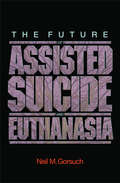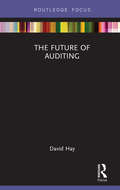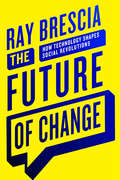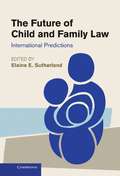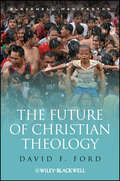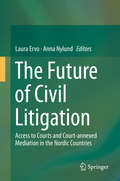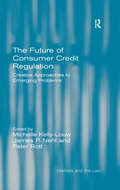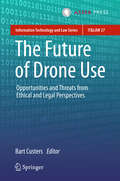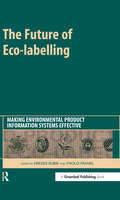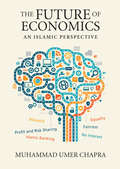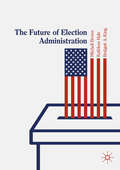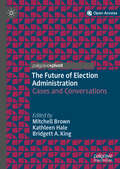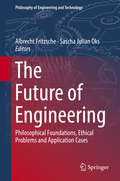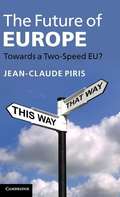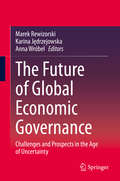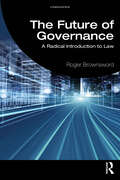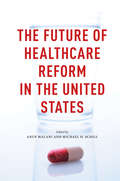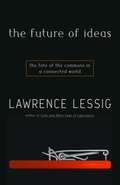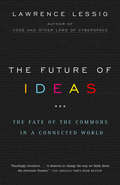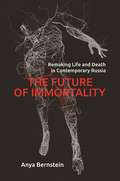- Table View
- List View
The Future of Assisted Suicide and Euthanasia
by Neil M. GorsuchThe Future of Assisted Suicide and Euthanasia provides the most thorough overview of the ethical and legal issues raised by assisted suicide and euthanasia--as well as the most comprehensive argument against their legalization--ever published. In clear terms accessible to the general reader, Neil Gorsuch thoroughly assesses the strengths and weaknesses of leading contemporary ethical arguments for assisted suicide and euthanasia. He explores evidence and case histories from the Netherlands and Oregon, where the practices have been legalized. He analyzes libertarian and autonomy-based arguments for legalization as well as the impact of key U.S. Supreme Court decisions on the debate. And he examines the history and evolution of laws and attitudes regarding assisted suicide and euthanasia in American society. After assessing the strengths and weaknesses of arguments for assisted suicide and euthanasia, Gorsuch builds a nuanced, novel, and powerful moral and legal argument against legalization, one based on a principle that, surprisingly, has largely been overlooked in the debate--the idea that human life is intrinsically valuable and that intentional killing is always wrong. At the same time, the argument Gorsuch develops leaves wide latitude for individual patient autonomy and the refusal of unwanted medical treatment and life-sustaining care, permitting intervention only in cases where an intention to kill is present. Those on both sides of the assisted suicide question will find Gorsuch's analysis to be a thoughtful and stimulating contribution to the debate about one of the most controversial public policy issues of our day.
The Future of Asylum in the European Union
by Flora A.N.J. Goudappel Helena S. RaulusThis book is based on a conference on the future of the European asylum policy at Erasmus School of Law in Rotterdam, the Netherlands. After a challenge set by the Dutch State Secretary for Justice, Ms Nebahat Albayrak, the contributions to this book focus on human rights aspects of the European asylum policy and the way the EU Member States need to cooperate in the future in order to reach results. The authors are scholars, policy makers and representatives of NGOs. In this way, many different aspects of the problems are put forward. In the introduction and the conclusion the editors evaluate the results of this broad cooperation. Valuable for academics, practitioners, policymakers and NGO's involved with European asylum policy issues.
The Future of Auditing (Routledge Focus on Accounting and Auditing)
by David HayThe Future of Auditing provides a concise overview of the function of auditing and the future challenges it faces, underpinned with suggestions for future research. It evaluates the key challenges facing the profession, such as quality, competition, and governance, as well as highlighting the under-explored areas of ethics, fraud, and judgement. The emphasis throughout is on the value of audit, and the importance of auditing research. Providing an original assessment of global versus national auditing, evidence-based auditing standards, and the structure of professional firms, David Hay critically examines the value of auditing from different standpoints. He critically reviews current assumptions about the value of audits of financial statements, and explores research opportunities and priorities to improve understanding of the value of auditing and its future role and function. This authoritative but accessible guide to the future of auditing and the challenges it faces will be useful not only to auditing researchers, but also to policy makers, standard setters, financial journalists, and auditing professionals seeking an accessible overview of current and future issues in auditing.
The Future of Change: How Technology Shapes Social Revolutions
by Ray BresciaIn The Future of Change, Ray Brescia identifies a series of "social innovation moments" in American history. Through these moments—during which social movements have embraced advances in communications technologies—he illuminates the complicated, dangerous, innovative, and exciting relationship between these technologies, social movements, and social change. Brescia shows that, almost without fail, developments in how we communicate shape social movements, just as those movements change the very technologies themselves.From the printing press to the television, social movements have leveraged communications technologies to advance change. In this moment of rapidly evolving communications, it's imperative to assess the role that the Internet, mobile devices, and social media can play in promoting social justice. But first we must look to the past, to examples of movements throughout American history that successfully harnessed communications technology, thus facilitating positive social change. Such movements embraced new communications technologies to help organize their communities; to form grassroots networks in order to facilitate face-to-face interactions; and to promote positive, inclusive messaging that stressed their participants' shared dignity and humanity. Using the past as prologue, The Future of Change provides effective lessons in the use of communications technology so that we can have the best communicative tools at our disposal—both now and in the future.
The Future of Child and Family Law
by Elaine E. SutherlandChild and family law tells us much about how a society operates, since it touches the lives of everyone living in that society. In this volume, a variety of experts examine child and family law in thirteen countries – Australia, Canada, China, India, Israel, Malaysia, The Netherlands, New Zealand, Norway, Russia, Scotland, South Africa and the United States. Each chapter identifies the imperatives and influences that have prevailed to date and offers informed predictions of how it will develop in the years to come. A common chapter structure facilitates comparison of the jurisdictions and, in the introduction, the editor highlights common trends and salient differences. The Future of Child and Family Law therefore provides practitioners, academics and policy-makers with access not just to an overview of child and family law in a range of countries around the world, but also to insights into what has shaped it and options for reform.
The Future of Christian Theology (Wiley-Blackwell Manifestos #55)
by David F. FordThe Future of Christian Theology represents a personal manifesto from one of the world's leading theologians, exploring the ways Christian theology in the twenty-first century has been, and can now continue to be, both creative and wise. Represents an outstanding and engaging account of the task of theology today Offers an insightful description of what makes for discerning and creative theology. Written from the perspective of decades of experience, and in close dialogue with theologians of other faiths Features a strong interfaith and public theology dimension, and a contemporary portrait of the field from the inside A hopeful and illuminating search for wisdom and understanding in the increasingly complex religious and secular world of the twenty-first century.
The Future of Civil Litigation
by Laura Ervo Anna NylundThis book offers an analysis of the current trends and developments in Nordic civil litigation and is divided into four main parts. In the first part a picture of the current civil litigation landscape is provided by focusing on whether there is a truly Nordic form of civil litigation, the current state of Nordic civil litigation, the recent major reforms of civil procedure legislation and the effects of Europeanization. In the second part, the way rules on court-connected mediation have been implemented and practiced in the Nordic countries is discussed. The authors offer their insights on why court-connected mediation has not been fully embraced by Nordic lawyers and the Nordic approach to this type of mediation is contrasted with the Austrian and German approaches. In the third part, recent developments affecting access to justice in the Nordic countries are discussed. Among the topics are changes in legal aid schemes, the impact of recent civil procedure law reforms, hindrances for larger companies to use litigation as a method of dispute resolution and differences in costs and delays. Additionally, Alternative Dispute Resolution and Class or Group Actions are explored as methods to enhance access to justice. The potential adverse effects of Alternative Dispute Resolution and Group Actions are also examined, both in a Nordic and European context. In the final part, conclusions are drawn from both historical and future-oriented perspectives.
The Future of Consumer Credit Regulation: Creative Approaches to Emerging Problems (Markets and the Law)
by Peter Rott Michelle Kelly-LouwEffective regulation of consumer credit in modern society is an ever-changing challenge. As new forms of credit emerge in free societies, regulation often lags behind. This volume explores contemporary problems related to the regulation of consumer credit in market economies with a focus on credit extended to the most vulnerable and poorest members of the community. Written by experts in the field of consumer credit regulation from Europe, North America, Australia and South Africa, the book examines some of the most important consumer credit issues facing consumers today and proposes innovative ways to protect the consumer interest in those markets.
The Future of Drone Use
by Bart CustersGiven the popularity of drones and the fact that they are easy and cheap to buy, it is generally expected that the ubiquity of drones will significantly increase within the next few years. This raises questions as to what is technologically feasible (now and in the future), what is acceptable from an ethical point of view and what is allowed from a legal point of view. Drone technology is to some extent already available and to some extent still in development. The aim and scope of this book is to map the opportunities and threats associated with the use of drones and to discuss the ethical and legal issues of the use of drones. This book provides an overview of current drone technologies and applications and of what to expect in the next few years. The question of how to regulate the use of drones in the future is addressed, by considering conditions and contents of future drone legislation and by analyzing issues surrounding privacy and safeguards that can be taken. As such, this book is valuable to scholars in several disciplines, such as law, ethics, sociology, politics and public administration, as well as to practitioners and others who may be confronted with the use of drones in their work, such as professionals working in the military, law enforcement, disaster management and infrastructure management. Individuals and businesses with a specific interest in drone use may also find in the nineteen contributions contained in this volume unexpected perspectives on this new field of research and innovation. Bart Custers is Associate Professor and Head of Research at eLaw, the Center for Law and Digital Technologies at Leiden University, The Netherlands. He has presented his work at international conferences in the United States, China, Japan, the Middle East and throughout Europe and has published over 80 scientific, professional and popularizing publications, including three books.
The Future of Eco-labelling: Making Environmental Product Information Systems Effective
by Frieder Rubik Paolo FranklEco-labelling is one of the key tools used by policy-makers in many parts of the world to encourage more sustainable production and consumption. By providing environmental information on products and services, eco-labels address both business users and consumers and range from mandatory approaches, such as required product declarations, to voluntary approaches, such as national eco-labels. Eco-labels can play an important role in environmental policy. They reward and promote environmentally superior goods and services and offer information on quality and performance with respect to issues such as health and energy consumption. Eco-labels fit well into a multi-stakeholder policy framework – as promulgated recently by the EU's integrated product policy (IPP) – since the development of criteria for labels and the acceptance in the market requires the involvement of a wide range of different parties, from government and business, to consumers and environmental organisations. However, many eco-labelling schemes have had troubled histories, and questions have been raised about their effectiveness. So, are eco-labels an effective tool to foster the development, production, sale and use of products and to provide consumers with good information about the environmental impacts of those products? Is eco-labelling useful to business as a marketing tool? What factors contribute to the development of successful schemes? More than ten years after its establishment, can the EU Flower be considered a success? Are national eco-labels such as the German Blue Angel and the Norwegian White Swan more effective? Should eco-labels be harmonised? Are eco-labels achieving their original aim of fostering sustainable production and consumption? For which product groups are ISO type I eco-labels appropriate and inappropriate? Are other labels, such as mandatory, ISO type II and ISO type III labels more effective in some cases? Are eco-labels focusing on the main environmental policy targets or just on "low-hanging fruit"? Are eco-labels really linked to other tools of IPP? The Future of Eco-labelling provides answers to all of these questions. Based on a major EU research exercise, the book plots a course for policy-makers to address some of the historic problems with eco-labelling, to learn what works and what doesn't and to move forward with schemes that can make a real difference to sustainable production and consumption.The book analyses the conditions under which eco-labelling schemes-both mandatory and voluntary-are or can become an efficient and effective tool to achieve given objectives; assesses previous experiences with eco-labels in different European countries and the relationship of these schemes with business strategies, IPP and market conditions; defines strategies aimed at linking eco-labels with other IPP measures; explores how eco-labels can be used to encourage sustainable consumption patterns, create green markets, foster innovation and development of green products and services, and implement multi-stakeholder initiatives; and sets out detailed recommendations for the future of eco-labelling.The book will be required reading for policy-makers, businesses involved with eco-labelling schemes and researchers interested in the development of sustainable production and consumption and IPP worldwide.
The Future of Economics: An Islamic Perspective
by M. Umer ChapraThis profound book is a powerful yet balanced critique of mainstream economics that makes a forceful plea for taking economics out of its secular and occident-centred cocoon. It presents an innovative and formidable case to re-link economics with moral and egalitarian concerns so as to harness the discipline in the service of humanity.M. Umer Chapra is ranked amongst the Top 50 Global Leaders in Islamic economics (ISLAMICA 500, 2015) and has been awarded with two prestigious awards for his contributions to the field: Islamic Development Bank Award for Islamic Economics (1989) and the King Faisal International Prize for Islamic Studies (1989).
The Future of Election Administration: Cases And Conversations (Elections, Voting, Technology)
by Kathleen Hale Mitchell Brown Bridgett A. KingStakeholders in the operation of American elections are keenly focused on policy reform, resource allocation, administrative professionalism, voter access and accessibility, equipment security, and system integrity. The Future of Election Administration is an edited volume that gathers the perspectives of today’s most forward-thinking practitioners and experts of policy, advocacy, and research about the importance of particular election practices, the professional and operational challenges that election administrators and voter registrars face, and emerging issues in the field. Through its combination of multiple perspectives to describe, analyze, and anticipate key dynamics and dilemmas as well as its emphasis on the practical aspects of administration, this book makes a unique contribution to the election administration literature.
The Future of Election Administration: Cases and Conversations (Elections, Voting, Technology)
by Kathleen Hale Mitchell Brown Bridgett A. KingAs the American election administration landscape changes as a result of major court cases, national and state legislation, changes in professionalism, and the evolution of equipment and security, so must the work of on-the-ground practitioners change. This Open Access title presents a series of case studies designed to highlight practical responses to these changes from the national, state, and local levels. This book is designed to be a companion piece to The Future of Election Administration, which surveys these critical dimensions of elections from the perspectives of the most forward-thinking practitioner, policy, advocacy, and research experts and leaders in these areas today. Drawing upon principles of professionalism and the practical work that is required to administer elections as part of the complex systems, this book lifts up the voices and experiences of practitioners from around the country to describe, analyze, and anticipate the key areas of election administration systems on which students, researchers, advocates, policy makers, and practitioners should focus. Together, these books add to the emerging body of literature that is part of the election sciences community with an emphasis on the practical aspects of administration.
The Future of Engineering: Philosophical Foundations, Ethical Problems and Application Cases (Philosophy of Engineering and Technology #31)
by Albrecht Fritzsche Sascha Julian OksIn a world permeated by digital technology, engineering is involved in every aspect of human life. Engineers address a wider range of design problems than ever before, raising new questions and challenges regarding their work, as boundaries between engineering, management, politics, education and art disappear in the face of comprehensive socio-technical systems. It is therefore necessary to review our understanding of engineering practice, expertise and responsibility.This book advances the idea that the future of engineering will not be driven by a static view of a closed discipline, but rather will result from a continuous dialogue between different stakeholders involved in the design and application of technical artefacts. Based on papers presented at the 2016 conference of the forum for Philosophy, Engineering and Technology (fPET) in Nuremberg, Germany, the book features contributions by philosophers, engineers and managers from academia and industry, who discuss current and upcoming issues in engineering from a wide variety of different perspectives. They cover topics such as problem solving strategies and value-sensitive design, experimentation and simulation, engineering knowledge and education, interdisciplinary collaboration, sustainability, risk and privacy.The different contributions in combination draw a comprehensive picture of efforts worldwide to come to terms with engineering, its foundations in philosophy, the ethical problems it causes, and its effect on the ongoing development of society.
The Future of Europe
by Jean-Claude PirisThe European Union is in crisis. Public unease with the project, Euro problems and dysfunctional institutions give rise to the real danger that the European Union will become increasing irrelevant just as its member states face more and more challenges of a globalised world. Jean-Claude Piris, a leading figure in the conception and drafting of the EU's legal structures, tackles the issues head on with a sense of urgency and with candour. The book works through the options available in light of the economic and political climate, assessing their effectiveness. By so doing, the author reaches the (for some) radical conclusion that the solution is to permit 'two-speed' development: allowing an inner core to move towards closer economic and political union, which will protect the Union as a whole. Compelling, critical and current, this book is essential reading for all those interested in the future of Europe.
The Future of Gay Rights in America
by H.N. HirschSandra Day O'Connor has called the gay rights movement "the first important civil rights struggle of the twenty-first century." Recent court decisions to overturn sodomy laws and to recognize gay marriage have emboldened activists, but have also resulted in a tremendous backlash, not the least of which has been a call for a constitutional amendment defining marriage as only between members of the opposite sex. Through its historical and legal contextualization of these decisions The Future of Gay Rights in America is essential for understanding an epochal moment in the history of gay rights.
The Future of Global Economic Governance: Challenges and Prospects in the Age of Uncertainty
by Marek Rewizorski Karina Jędrzejowska Anna WróbelIn light of new global challenges for international cooperation and coordination, such as the revival of protectionism, surge of populism, or energy-related issues, this volume highlights possible scenarios for the future of Global Economic Governance (GEG). The contributing authors analyze the substance of GEG as a normative framework for resolving collective action issues and promoting cross-border co-ordination and co-operation in the provision or exchange of goods, money, services and technical expertise in the world economy. Furthermore, the book examines drivers of fundamental shifts in global economic steering and covers topics such as power and authority shifts in the global governance architecture, technological and energy-related challenges, and the role of the G20 and BRICS in shaping global economic governance.“This book provides a very timely and nuanced account of the challenges facing the established global order.”Andrew F. Cooper (Professor of Political Science at the University of Waterloo)“This valuable collection from a new generation of innovative scholars of global economic governance offers insights from a broad range of theoretical approaches to the central policy issues of the day”John Kirton (Director of the Global Governance Program, Munk School of Global Affairs, University of Toronto)
The Future of Governance: A Radical Introduction to Law
by Roger BrownswordThis book offers a radically different introduction to law, one that reflects the challenges and opportunities presented by the rapid technological developments of our time.Traditionally, law has been about historic principles and rules and their application to a particular set of facts; and courts, judges, and disputes have been central to the legal enterprise. Against this approach, this book highlights four radical and revisionist ideas: by bringing modern technologies into the foreground; by presenting law as one particular mode of governance in a larger picture of governance that now includes technological modalities; by insisting that we have to think outside the traditional doctrinal box to engage with a broad range of governance questions; and by emphasising that human communities cannot flourish without good governance to which both lawyers and law are central. These four radical threads are woven into a discussion of the modern landscape of law, and together they offer a distinctly contemporary contribution to the quest for good governance. The challenge for lawyers now, the book maintains, is to contribute to thinking, both locally and globally, about how we take advantage of the opportunities presented by the newest technology, without compromising the essential conditions for human life and co-existence, and without losing what we value in law’s governance.This book is aimed at students who are studying law at university and legal academics, and others, interested in the current and future impact of technology on law.
The Future of Healthcare Reform in the United States
by Anup Malani Michael H. SchillIn the years since the passage of the Patient Protection and Affordable Care Act (PPACA, or, colloquially, Obamacare), most of the discussion about it has been political. But as the politics fade and the law's many complex provisions take effect, a much more interesting question begins to emerge: How will the law affect the American health care regime in the coming years and decades? This book brings together fourteen leading scholars from the fields of law, economics, medicine, and public health to answer that question. Taking discipline-specific views, they offer their analyses and predictions for the future of health care reform. By turns thought-provoking, counterintuitive, and even contradictory, the essays together cover the landscape of positions on the PPACA's prospects. Some see efficiency growth and moderating prices; others fear a strangling bureaucracy and spiraling costs. The result is a deeply informed, richly substantive discussion that will trouble settled positions and lay the groundwork for analysis and assessment as the law's effects begin to become clear.
The Future of Healthcare Reform in the United States
by Michael H. Schill Anup Malani and Michael H. SchillIn the years since the passage of the Patient Protection and Affordable Care Act (PPACA, or, colloquially, Obamacare), most of the discussion about it has been political. But as the politics fade and the law's many complex provisions take effect, a much more interesting question begins to emerge: How will the law affect the American health care regime in the coming years and decades? This book brings together fourteen leading scholars from the fields of law, economics, medicine, and public health to answer that question. Taking discipline-specific views, they offer their analyses and predictions for the future of health care reform. By turns thought-provoking, counterintuitive, and even contradictory, the essays together cover the landscape of positions on the PPACA's prospects. Some see efficiency growth and moderating prices; others fear a strangling bureaucracy and spiraling costs. The result is a deeply informed, richly substantive discussion that will trouble settled positions and lay the groundwork for analysis and assessment as the law's effects begin to become clear.
The Future of Ideas
by Lawrence LessigLawrence Lessig informs us about the downfalls of today's technological advancements and the emerging threat to our freedom as well as to our innovative spirit. The author and publisher of this book donated a digital copy to Bookshare.org. Join us in thanking Lawrence Lessig and Random House for providing this accessible digital book to this community.
The Future of Ideas: The Fate of The Commons in a Connected World
by Lawrence LessigThe Internet revolution has come. Some say it has gone. InThe Future of Ideas, Lawrence Lessig explains how the revolution has produced a counterrevolution of potentially devastating power and effect. Creativity once flourished because the Net protected a commons on which widest range of innovators could experiment. But now, manipulating the law for their own purposes, corporations have established themselves as virtual gatekeepers of the Net while Congress, in the pockets of media magnates, has rewritten copyright and patent laws to stifle creativity and progress. Lessig weaves the history of technology and its relevant laws to make a lucid and accessible case to protect the sanctity of intellectual freedom. He shows how the door to a future of ideas is being shut just as technology is creating extraordinary possibilities that have implications for all of us. Vital, eloquent, judicious and forthright,The Future of Ideasis a call to arms that we can ill afford to ignore.
The Future of Immortality: Remaking Life and Death in Contemporary Russia (Princeton Studies in Culture and Technology #23)
by Anya BernsteinA gripping account of the Russian visionaries who are pursuing human immortalityAs long as we have known death, we have dreamed of life without end. In The Future of Immortality, Anya Bernstein explores the contemporary Russian communities of visionaries and utopians who are pressing at the very limits of the human.The Future of Immortality profiles a diverse cast of characters, from the owners of a small cryonics outfit to scientists inaugurating the field of biogerontology, from grassroots neurotech enthusiasts to believers in the Cosmist ideas of the Russian Orthodox thinker Nikolai Fedorov. Bernstein puts their debates and polemics in the context of a long history of immortalist thought in Russia, with global implications that reach to Silicon Valley and beyond. If aging is a curable disease, do we have a moral obligation to end the suffering it causes? Could immortality be the foundation of a truly liberated utopian society extending beyond the confines of the earth—something that Russians, historically, have pondered more than most? If life without end requires radical genetic modification or separating consciousness from our biological selves, how does that affect what it means to be human?As vividly written as any novel, The Future of Immortality is a fascinating account of techno-scientific and religious futurism—and the ways in which it hopes to transform our very being.
The Future of Indian and Federal Reserved Water Rights: The Winters Centennial
by Barbara Cosens Judith V. RoysterOn January 6, 1908, the Supreme Court ruled that when land is set aside for the use of Indian tribes, that reservation of land includes reserved water rights. The Winters Doctrine, as it has come to be known, is now a fundamental principle of both federal Indian law and water law and has expanded beyond Indian reservations to include all federal reservations of land. Ordinarily, there would not be much to say about a one hundred-year-old Supreme Court case. But while its central conclusion that a claim to water was reserved when the land was reserved for Indians represents a commitment to justice, the exact nature of that commitment-its legal basis, scope, implications for non-Indian water rights holders, the purposes for and quantities of water reserved, the geographic nexus between the land and the water reserved, and many other details of practical consequence-has been, and continues to be, litigated and negotiated. In this detailed collection of essays, lawyers, historians, and tribal leaders explore the nuances of these issues and legacies.
The Future of International Courts: Regional, Institutional and Procedural Challenges (Routledge Research in International Law)
by Jamie Trinidad Nikos Skoutaris Avidan KentThe end of World War II marked the beginning of a new golden era in international law. Treaties and international organisations proliferated at an unprecedented rate, and many courts and tribunals were established with a view to ensuring the smooth operation of this new universe of international relations. The network of courts and tribunals that exists today is an important feature of our global society. It serves as an alternative to other, sometimes more violent, forms of dispute settlement. The process of international adjudication is constantly evolving, sometimes in unexpected ways. Through contributions from world-renowned experts and emerging voices, this book considers the future of international courts from a diverse range of perspectives. It examines some of the regional, institutional and procedural challenges that international courts face: the rising influence of powerful states, the turn to populism, the interplay between courts, the involvement of non-state actors and third parties in international proceedings, and more. The book offers a timely discussion of these challenges, with the future of several international courts hanging in the balance and the legitimacy of international adjudication being called constantly into question. It should also serve as a reminder of the importance of international courts for the functioning of a rules-based international order. ‘The Future of International Courts’ is essential reading for academics, practitioners and students who are interested in international law, including those who are interested in the role international courts play in international relations.
